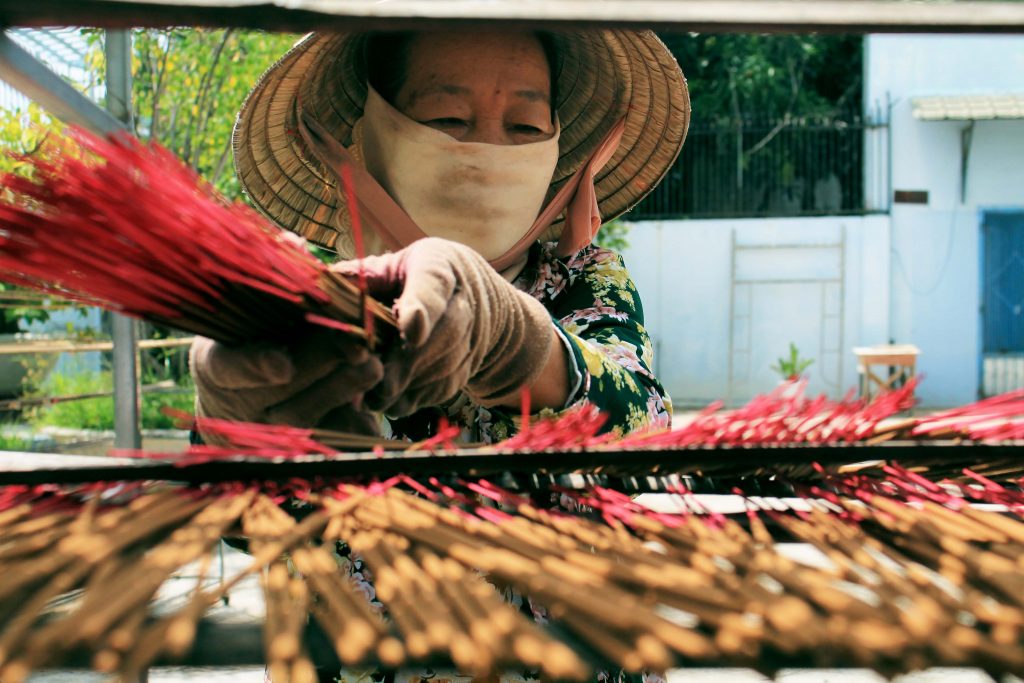The importance of incense in Vietnamese life

Having roots in China, India and Japan, incense is an irreplaceable part of traditional festivals and religious ceremonies in Oriental countries. In Vietnam, in particular, incense offering is a harmonious combination of art and culture.
In Vietnamese, incense is known as “Hương” or “Nhang” (“Hương” in the North and “Nhang” in the South). For centuries, Vietnamese people have burned “Nhang”, from modest temples to prestigious pagodas, from humble village huts to luscious houses. Incense is offered when a family member dies, a baby is born, or as a way to pray for and commemorate ancestors.

Apart from its obvious virtues in religious and spiritual practices in helping people to communicate with the spiritual life, the fragrance and smoke from that wafts from incense candles helps people to ease fatigue and stress. In addition, there are many kinds of natural incense that can assist to purify and bring the harmony back to the surrounding atmosphere.
For the craftsman who have spent most of their lives making “Nhang”, like the husband and wife team – Mrs. Hồng & Mr. Phú – creators of the high quality incense brand (Đồng Tiến) in Nha Trang, they believe that incense was “born” from their hearts, love and thoughts instead of saying it was “made” from their hands. It is not hard to find necessary materials to make incense, as Vietnam has an abundance of resources and natural ingredients such as fragrant wood, resins, gums and herbs.

“The very first step is also the most difficult one that is choosing the suitable ingredients to combine and it is very important to use the right combination and quantity of each ingredient.
It is very important to choose the ingredient that provides the main aroma, and the secondary ingredient that helps to spread it across the room and combine the fragrances”, explains Mrs. Hong.
Depending on different specific uses, there are different types of incense that are classified according to their ingredients, size and shape. For instance, based on the difference of shape, we have “incense stick” (Nhang cây or nhang nén) and “incense cone” (nhang khoanh or nhang vòng). On the other hand, there are many different scents such as frankincense incense (Nhang Trầm), Cinnamon incense (Nhang Quế) or special types combined from various kinds of herbs – usually called herbal incense (Nhang thảo dược).
“No matter what type of incense we make, it is a principle to use the best ingredients if we want to create the best quality incense. Some people decide to save costs by using cheap materials and chemicals, but that will cause toxic and harmful incense effects when burned, said Mr. Phúc.

Sharing with DNT Team, the wife and husband team were happy to give us some tips for distinguishing real incense (using natural ingredients) from fake incense (using chemicals).
“Real incense often has a brown color that is the real color of the wood while fake incense has a much yellower appearance. Fake incense has very strong smells like perfume and releases much more smoke when burned whereas real incense has a very latent aroma that is very good for your health and lasts for a long time.
Finally, while real incense is very long lasting in that it can be stored and used over a long period of time, the fake one must be used quickly or it will lose all its color and fragrance.
In inseparable part of Vietnamese cultural and spiritual life, you can find incense in any local market, and even if you are not Buddhist or particularly religious, the wonderful aroma of a burning incense stick in your home can bring balance, peace and serenity.



